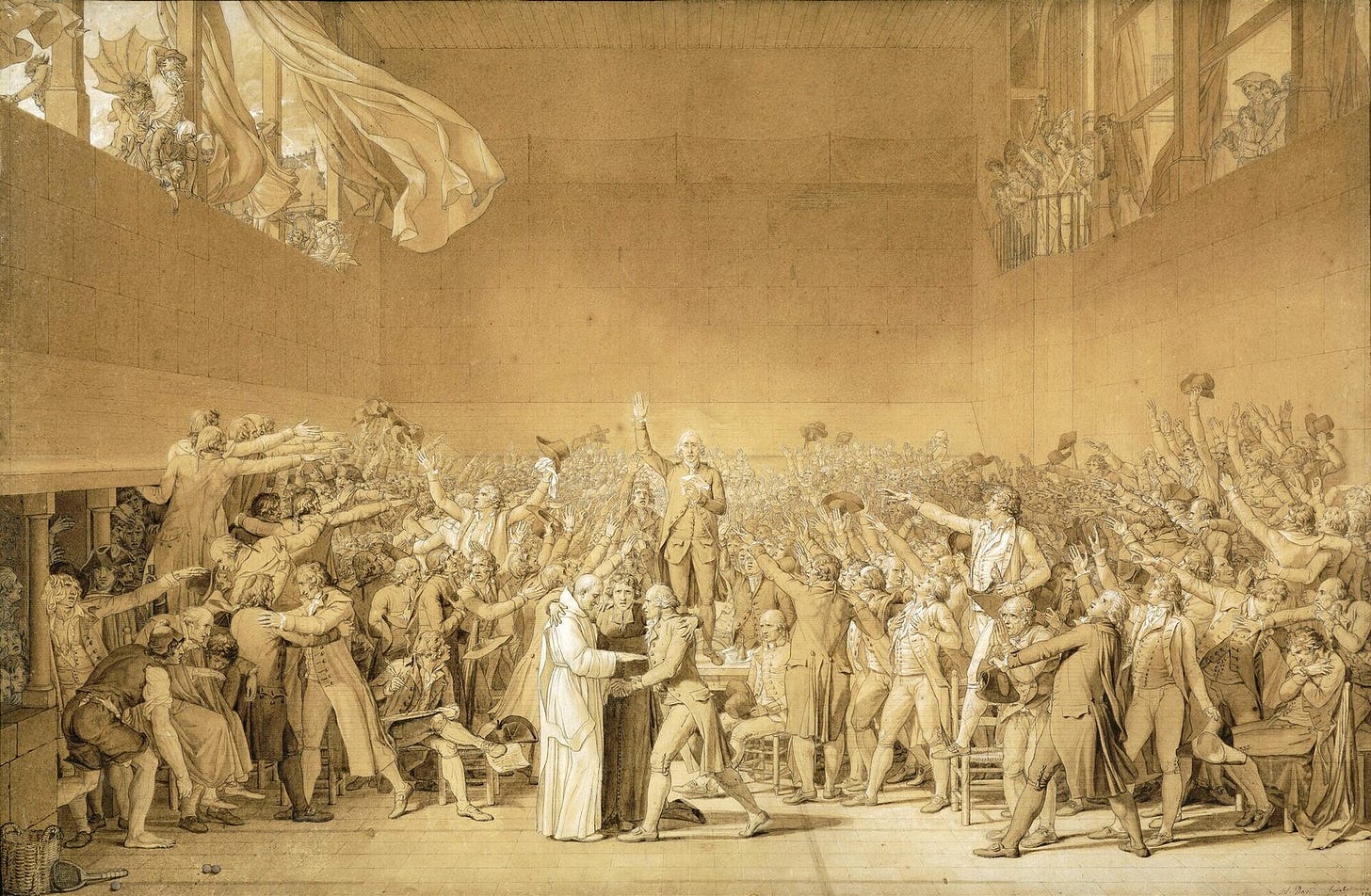Hi all, and welcome back to rumblewrites. This week’s post is another #onthisday historical deep-dive. This time, it’s about a key event in the early days of the French Revolution (shocker): the Tennis Court Oath.
If you enjoy this post, you can check out my other historical content here, and subscribe for more:
How did we get here?
Mere weeks before the storming of the Bastille, the King had called for an Estates-General, a legislative assembly composed of representatives from France’s 3 Estates: the clergy (First Estate), the nobility (Second Estate), and the commoners (Third Estate). This was the first time and Estates-General had been called since 1614, and Louis XVI had hoped that it would help solve the country's fiscal and agricultural crisis. However, the group immediately ran into a problem: there was no proportional representation. Each Estate had the same voting power, meaning that while the Third Estate represented c.98% of the French population, it could be out-voted by the remaining 2%. Put simply, the system clearly favoured the nobility and clergy in a way which did not sit right with contemporary French society.
Realising that any attempt they gave at reform would be outvoted by the first 2 Estates, the Third Estate refused to sit in their delegated sections and instead banded together to form a group they called a National Assembly on 17 June. They were soon joined by some sympathetic members of the other Estates. A few days later, in an attempt to stop the Assembly from meeting, Louis XVI ordered the doors of the Salle des Menus-Plaisir (where the Estates-General was being held) to be locked and guarded by soldiers. Fearing that an attack against them was imminent, the National Assembly congregated in a nearby tennis court and drafted the Serment du Jeu de Paume (The Tennis Court Oath).
Tennis Court Oath
The Tennis Court Oath was drafted by Antoine Barnave and Isaac Le Chapelier. It was inspired by the 1776 United States Declaration of Independence and, according to some historians, represented the start of the French Revolution. All but one of the 577 members from the Third Estate took the oath. It read:
Nous jurons de ne pas nous séparer, et de nous rassembler partout où les circonstances l'exigeront, jusqu'à ce que la Constitution du royaume soit établie et affermie sur des bases solides.
We swear that we will not separate, and that we will come together whenever circumstances require it, until such time as the Kingdom’s Constitution is established and consolidated on solid foundations.
Translation by me.
Jacques-Louis David, ‘Le Serment du Jeu de paume’ (1791)
The oath, therefore, was a pledge. A pledge not to disband until France had a Constitution. It asserted that political authority derived from the people and their representatives rather than the monarchy. This was a radical undoing of the system of absolute monarchy which had governed France for so long.
In an attempt to prevent further meetings, the King’s brother: the count of Artois rented out the tennis court on the days following. But the newly-formed National Assembly simply relocated to the Versailles Cathedral. And by the 27th June, the King was forced to relent. He formally requested that voting occur based on head count, and he ordered the clergy and nobility to join the Third Estate in the National Assembly (an order which gave the illusion that he controlled it). This granted the Third Estate the power they desired, and gave credence to the notion of the power of the people, an idea which came to define the Revolution thereafter.
Recommended reading
Alpaugh, Micah, ‘Part II - The French Revolution Radicalizes Social Movement’ in: Friends of Freedom: The Rise of Social Movements in the Age of Atlantic Revolutions (Cambridge University Press, 2021), pp. 223-430
Fitzsimmons, Michael P., The Remaking of France: The National Assembly and the Constitution of 1791 (Cambridge University Press, 2009) [especially Part 1, pp. 1-140]
Johnson, Eric F., ‘Tennis Court Oath, France, 1789’, in: The International Encyclopedia of Revolution and Protest (John Wiley & Sons, 2009)
Robinson, James Harvey, ‘The Tennis Court Oath’, Political Science Quarterly vol.10 no.3 (Oxford University Press, 1895), pp. 460-474





